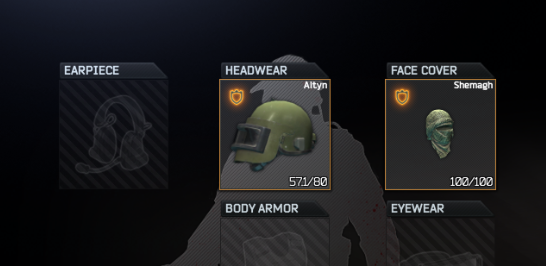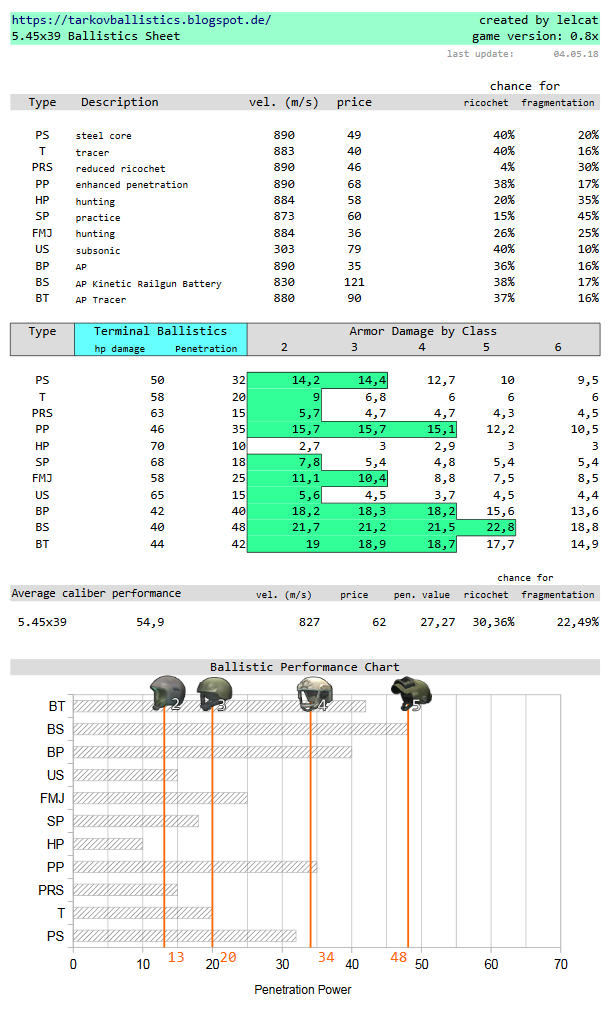Armor Basics
Let's talk about armor.
The game features two different armor types currently, helmets and armor vests. Armor vests protect the chest and stomach, while the 6b43 armor vest also extends protection to the arms. The body parts protected can be verified by mouse over pointing over "armor zones"
Tarkov Ballistics sheet for the 5.45 ( link )
The base damage from the bullet will be roughly 36 to the body part behind it, although this number can vary. A penetrating hit will, on average, reduce the incoming health damage by 28%.
Let's consider another example. A 7.62x25 round is fired from a TT pistol at class 3 body armor. In the first test run, we will use the all popular LRNPC round.
The Altyn helmet was provided by Broceidon for testing.
The game features two different armor types currently, helmets and armor vests. Armor vests protect the chest and stomach, while the 6b43 armor vest also extends protection to the arms. The body parts protected can be verified by mouse over pointing over "armor zones"
6b43 protects the arms, not just the center of mass.
Helmets protect only the parts of the head that they physically cover. This is a new addition for 0.8.
Note that the different attachment armor parts also provide different protection levels. The visor armor class is 4 on the Altyn helmet, while the helmet itself is class 5.
Armor Damage
When a bullet strikes a piece of armor, several things are considered by the game:
- Caliber
- Ammo Type
- Armor
Tarkov Ballistics sheet for the 5.45 ( link )
Caliber
The first consideration is the caliber. This is the diameter of the bullet, designated in milimeters, like for the 5.34x39mm. Other designations are .366, which means 0.366 inches and translates to 9,29 milimeters. The actual size of the whole cartridge is larger, because this is the part that contains the gunpowder to propel the bullet out of the barrel.
Ammo Type
The second consideration is the ammo type. The 5.45x39 caliber has 11 different ammo types in EFT. On our chart you can see different performance characteristics. The 3 most important ones are health damage, penetration power and armor damage. Health damage is the damage applied to a body part when it is not protected by armor. Penetration Power is an internal value that supposedly represents the kinetic energy of the bullet when it hits a target. Armor damage depends on the armor and the penetration power of the bullet.
Higher armor classes will reduce the armor damage received.
Armor
This is the type of vest or helmet that makes contact with the bullet.
What happens when a bullet hits armor
Let's assume a PS round fired from an AK74 hits a class 3 armor vest. We can read from the ballistics performance chart that it has enough power to penetrate the armor (Penetration Power 32, armor class 3 can resist up to level 20).The bullet will strike through and damage the body part behind the armor.
Let's consider another example. A 7.62x25 round is fired from a TT pistol at class 3 body armor. In the first test run, we will use the all popular LRNPC round.
It features 66 base damage, but only 6 penetration power. When we start shooting at a class 3 armor vest with 45 armor points, it will take a long time to wear the vest down, as it only does 1.6 ap damage. Once we finally arrive at ~7 ap remaining on the vest, something magical will happen, the armor will start giving in and letting damage through. This would require 25 shots on the vest of the target, making it highly unlikely the target will cooperate to stand around long enough for the shooter to land 25 hits.
Let's try the same thing with the PST round. It only offers 50 base damage, but a massive 19 penetration power, which puts it above class 2 armor penetration by margin. The bullet still can not penetrate class 3 armor, for that penetration power of 21 would be required. Many players appear to avoid any round for the TT that is not a LRNPC for this reason. Because if no bullet can get class 3 armor, then we can just take the one with the highest base damage. Makes sense?
It does not.
Repeated shots on the vest will cause the first few shots to fail to penetrate, as expected. However it takes out ~6.1 ap on each hit. This means the vest will be worn down 4 times faster. 8 hits, or one full magazine will zero the vest.
But that is not all. The vest will start failing to protect at ~17 ap. The point at which a damaged vest will fail to protect depends on the penetration power of the bullet. This means PST will start damaging the target after 6 hits, compared to 25 hits with LRNPC.
It does not.
Repeated shots on the vest will cause the first few shots to fail to penetrate, as expected. However it takes out ~6.1 ap on each hit. This means the vest will be worn down 4 times faster. 8 hits, or one full magazine will zero the vest.
But that is not all. The vest will start failing to protect at ~17 ap. The point at which a damaged vest will fail to protect depends on the penetration power of the bullet. This means PST will start damaging the target after 6 hits, compared to 25 hits with LRNPC.
Health Damage
If a 7.62x25 LRNP penetrates armor, it applies ~48 damage on a chest hit. this is a damage reduction of 28%. This number is consistent for all calibers. This means even wearing a vest that is too weak to protect from a penetration is still better than no vest. If a 7.62x39 HP (SKS, AKM) round would hit the chest without any armor, it would be a one shot kill. But even a weak armor vest will reduce that damage to below one shot damage.
Conclusions
- Two types or armor items currently exist in the game. Helmets and vests.
- Each armor piece can have different parts of the body it protects.
- Helmet armor can be upgraded with more armor items which in turn add a new layer of protection. The armor provided on visors is always lower than the helmet armor (except for kolpak visor)
- The head bodypart is only protected where there is helmet armor physically covering it.
- Penetration Power of an ammo type governs how much energy the bullet has to penetrate armor. Higher penetration power equals higher armor damage, but it also indirectly equals less health damage in most ammo types.
- Armor will only guarantee protection up to a certain level of armor points left. That level depends on the bullet hitting. Bullets with high penetration power will get through the AP barrier sooner than weaker bullets.
- Even armor too weak to stop a bullet will lower the damage of it by ~28%.
The Altyn helmet was provided by Broceidon for testing.












Thank you very much, for your thorough work!
AntwortenLöschen